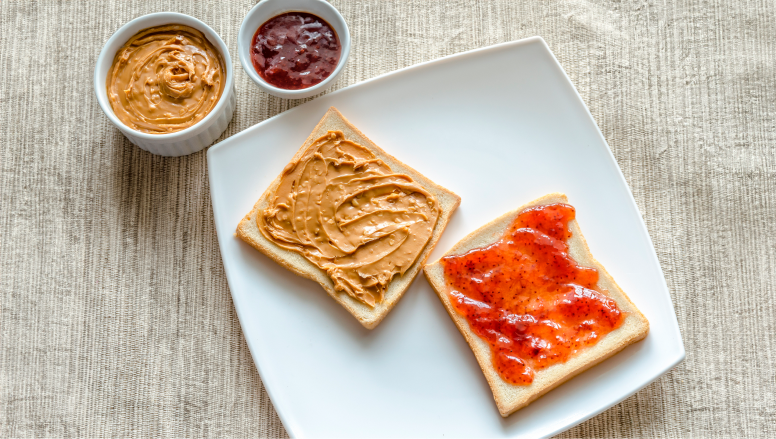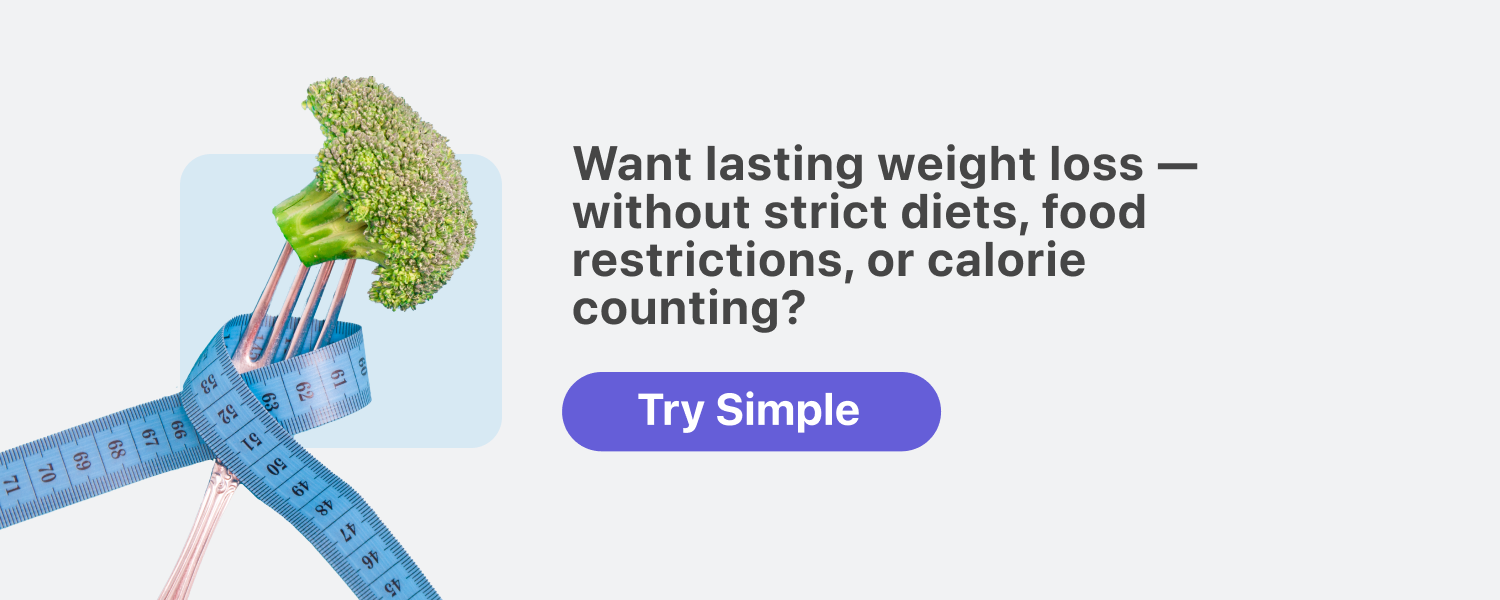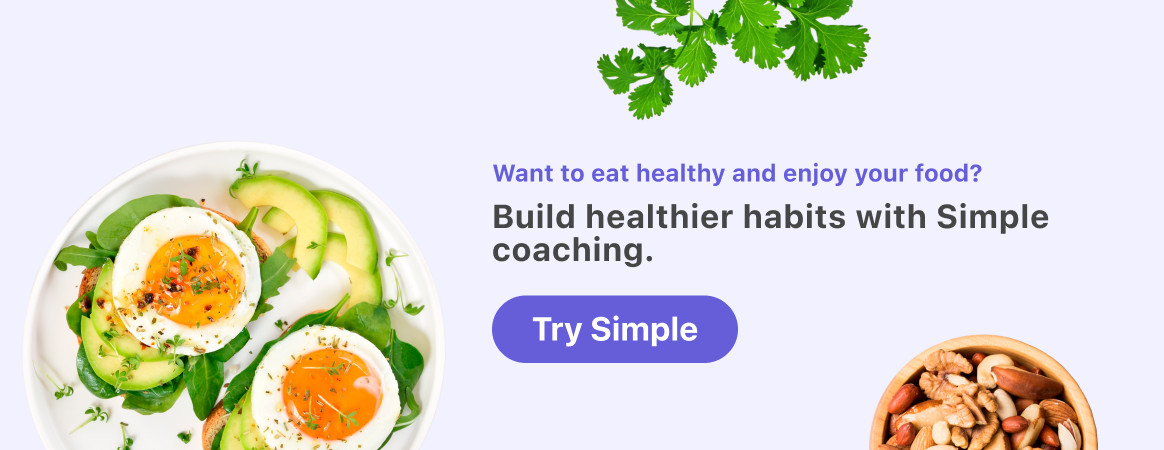12:12 vs. 16:8 intermittent fasting — explained by Simple

Which is better:
Cats or dogs? Peanut butter or jelly? Ketchup or mustard?
We all love a good comparison question, and the world of intermittent fasting isn’t immune. Judging by online searches, the people of the internet are often eager to learn which intermittent fasting schedule comes out on top.

Let’s put a couple of heavyweight fasting schedules into the ring and find out:
12:12 vs. 16:8. Which will be crowned Ultimate Intermittent Fasting Champion?
(Spoiler alert: it’s going to depend on your goals.)

What is 16:8 intermittent fasting?
16:8 goes like this:
Eat all your meals during an 8-hour period. Fast for the remaining 16 hours.
If you’re a newbie to intermittent fasting, you’re likely thinking, “Woah. 16 hours without so much as an apple? How is that even possible?!”
Before you flip your laptop closed and banish all ideas of intermittent fasting from your mind, think about this:
You’ll knock out a big chunk of those 16 hours overnight when you’re asleep. Then, hold off on breakfast, and you’re home free with a 16-hour fast in the bag.
If you love breakfast, though, no sweat. Start your fast with an early dinner and roll straight into overnight fasting that way.
What is 12:12 intermittent fasting?
If a 16-hour fast feels too hard to handle, maybe 12-hour intermittent fasting could ride to the rescue. With 12:12, your day gets split up like this:
Fast for 12 hours, leaving the other 12 hours to eat all your meals.
A 12-hour fast will likely fit far more neatly into your life (though it still takes effort). Perhaps you quit eating after dinner at 8 PM, then break your fast with breakfast at 8 AM. It’s a much more easygoing approach, with only a few waking hours when you might feel hunger or cravings.
This makes it an ideal intermittent fasting schedule for beginners. If you’re a beginner, you don’t have to start your intermittent fasting journey alone — we’re right here to help. Try our Simple quiz to get up and running today!
The difference between 16:8 and 12:12 intermittent fasting

Aside from the obvious difference (the length of the fast, ICYMI), there are a few ways these two fasting schedules differ.
When — or if — you hit ketosis
You could hit ketosis — when your body starts burning your fat stores for fuel [1] — with both 16:8 and 12:12.
But it’s not guaranteed either, and it’s more likely with 16:8.[2] Some people don’t get into ketosis on 12:12 simply because the fasts are shorter, although other factors can influence it too, like your age, how active you are, how much carbohydrate you eat, and so on.
The calorie deficit
There’s no need to count calories with intermittent fasting (one of its most winning features, in our eyes). The fasts cut your calories for you. The longer the fast, the greater the calorie deficit (when you burn more calories than you eat) you’ll experience.
Based on the average recommended calorie allowance (2,000 kcals for women; 2,500 kcals for men), it stacks up like this:
- 12:12: deficit of roughly 200 calories
- 16:8: deficit of roughly 300–400 calories
Of course, this will vary depending on what you eat. To help you hit these numbers, check out what to eat during intermittent fasting and get some ideas on how to stay full, nourished, and energized while keeping your calories where you want them.
The side effects
Intermittent fasting has some potential side effects — like increased hunger, ragey cravings, grumpy moods, and increased snaccidents — especially at the start of your fasting journey.
These tend to increase with the length of the fast, so you’re likely to meet these guys more often and more intensely if you kick off with 16:8 compared to 12:12.
They should subside with time, but if you have any severe or consistent side effects, speak with your doctor.
Benefits of 12:12 and 16:8 intermittent fasting
Here’s a brief rundown on how intermittent fasting can support your health.
Weight loss
Weight loss is one of intermittent fasting’s best-known benefits.
Generally speaking, there’s more evidence to support 16:8’s efficacy for weight loss results for those living with overweight and obesity.[3] As we saw earlier, 16:8 creates a bigger calorie deficit.
That said, 12:12 can lead to weight loss for those living with obesity, as this study discovered,[2] and also helps you lay the groundwork for longer fasts.
Improved blood glucose control
Frequent fasting can improve the body’s ability to respond to insulin — a hormone that breaks down the carbohydrates we eat — which can help lower the risk of developing type 2 diabetes.[4] However, these benefits may be more likely for those who are overweight or have obesity.
Increased cardiovascular health
Studies have shown that intermittent fasting may help to reduce LDL cholesterol and triglycerides, two common risk factors for heart disease,[5] though the researchers did state that these benefits may not be deemed clinically significant.
There is good evidence, however, to suggest that intermittent fasting can significantly lower systolic blood pressure.[6]
Anti-inflammatory effects
Intermittent fasting may enhance the body’s resistance to oxidative stress. This can help lower inflammation, which can often lead to chronic diseases.[7,8]
Risks of 12:12 and 16:8 intermittent fasting
Of course, there are a few risks with intermittent fasting. Let’s check them out.
Dehydration
Fasting can result in dehydration, leading to headaches, fatigue, and that groggy feeling we know from hot days (or drunken nights).
Make sure to drink plenty of water or other low-calorie fluids during both your fasting and eating windows. Check out our guide on what you can drink while fasting to keep your drinking choices fresh and interesting.
Disordered eating
Intermittent fasting, while flexible, still includes aspects that can feel like rules. For some people, that can trigger disordered eating behaviors, like binging or restricting.[9,10]
If this happens, and/or you feel that fasting is having a negative impact on your thoughts and feelings, then it’s likely that intermittent fasting is not the kindest or safest way for you to lose weight. Stop and speak to your healthcare provider for support in finding a method that suits your needs.
Weight gain
Sometimes fasting can kick your hunger and cravings into overdrive. Perhaps you exercised more than usual, didn’t sleep well,[11] or your stressors increased — things like this can push your appetite cues out of whack (even if you’re not fasting).
When that happens, it’s hard to make wise food choices. The chocolate (or chips or wine … ) will call to you, and it’s tough to resist.
Having a meal plan and some health-promoting, tasty meals / snacks prepped and ready to go will make it easier to grab what you need rather than what your sleep-deprived, stressed-out, exercise-weary cravings are clamoring for.
Are 12:12 and 16:8 intermittent fasting safe?
For most people, both 12:12 and 16:8 intermittent fasting are safe.
But not for everybody. This includes people who:
- are under 18 or 80 years or older
- have a Body Mass Index (BMI) <18.5
- take prescription medications
- have (or are at risk of having) an eating disorder or have a history of one
- have a medical condition
- are extremely active
- are pregnant, breastfeeding, or trying to conceive
If any of these apply to you, don’t try 12:12 or 16:8 intermittent fasting (or anything in between!) unless you have your doctor’s permission.
Pros and cons of the 12:12 and the 16:8 intermittent fasting method
| Pros of 12:12 | Cons of 12:12 |
| Flexible and easy to follow | Can increase hunger and cravings |
| Can support weight loss | You may feel irritable and headachy |
| Improved insulin resistance | You may not achieve ketosis |
| Fits easily into life | Weight loss potential is limited |
| Pros of 16:8 | Cons of 16:8 |
| Flexible and easy to follow | Can increase hunger and cravings |
| More likely to hit ketosis | Long fasts can be challenging |
| Weight loss potential is greater | You may get dehydrated or overeat |
| Improved insulin resistance | May interfere with work / social life |
How to get started with 12:12 or 16:8 intermittent fasting
If you’re eager to get started on your intermittent fasting journey, here are four steps to help:
- Choose your fasting schedule
In the battle of 12-hour fasting vs. 16-hour fasting, which one has won your heart?
Once you’ve got that locked down — and before you move on to step two — take our Simple quiz and get set up with the smart tools to help you manage your fasting schedule. We’ve got reminders to make sure you remember to fast, eat, and drink, plus a food journal to log your meals and insights aplenty to help you lean into the change process.
- Decide your fasting hours
Are you going to eat earlier and finish earlier (science suggests this is the way to go for optimum results,[12]) or do you prefer a later eating time?
It’s totally your call. Play around with some options to see what fits you best.
- Write a meal plan
It doesn’t have to be super fancy or long. Even a few days will help.
If you’re 16:8-ing, get a head start with our 16:8 intermittent fasting 7-day meal plan, and if you’re 12:12-ing, check out our intermittent fasting meal planning how-to guide.
- Keep your mind occupied
At first, your belly — and how loudly it’s growling — may be all you can think about. But you can get through it.
Do something nice for your brain to help distract from these sensations. Listen to music, do some meditation (if you enjoy it), phone a friend, do a puzzle, make, paint, or knit something. (We don’t recommend baking at this juncture unless you have a masochistic streak.)
Being mentally engaged with an activity is a powerful way to keep hunger from derailing your fast.[13]

5 pro tips on how to choose the right intermittent fasting schedule for you
Here are the five best tips we can give you on choosing the right intermittent fasting schedule for you.
- Experiment
Dip your toe in the water and see how regular fasting feels. You won’t know till you try!
- Start small
Try 12:12 to start off with. If that works well and you’re eager to go bigger, expand your fasting practice to 14:10. Let your intermittent fasting schedule grow with you.
- Fasting has to fit your life
Choose a fasting schedule that works for your lifestyle rather than contorting your lifestyle to fit fasting.
If life is non-stop busy, and you need plenty of energy to power through but don’t have much time to eat, a longer eating window gives you more options. 12:12, 14:10, or 16:8 intermittent fasting could be perfect.
If life is relaxed and breezy — and you’ve ample time for meal prep — a shorter eating window could work great. Perhaps 18:6 or 20:4 could be your ideal intermittent fasting routine.
- Give yourself time
It may well feel all kinds of weird to start with. Perhaps your hunger is off the charts, you accidentally break your fast now and then, and you’re more snappish for a while.
Let yourself settle in. Let your body and mind adapt. It’ll get easier.
If it doesn’t, try a different schedule. It’s all part and parcel of the learning process.
- Stay flexible
Our bodies are always changing, so we gotta stay tuned in.
The intermittent fasting schedule that’s right for you now may not be ideal if you change your job. Or your fitness regime. Or while you’re moving house.
Stay flexible and adjust your fasting times to suit your needs as they evolve.
- Some intermittent fasting schedules are best left alone
A bonus tip from the Simple team:
When choosing the right intermittent fasting schedule for you, choose a time-restricted eating (TRE) option like 12:12, 14:10, 16:8, or 18:6 intermittent fasting. TRE intermittent fasting schedules are kinder to your body, safe, and plenty effective.
If you have your doctor’s approval, the 5:2 diet and alternate-day fasting could be options … but always take a hard pass on fasting schedules like Eat Stop Eat, water fasting, dry fasting, Warrior diet, and OMAD. They carry more risks without bringing any more benefits.
Frequently asked questions about 12:12 vs. 16:8 intermittent fasting
For weight loss, a 12-hour fast is not as good as a 16-hour fast.
But as an effective way to start your fasting journey, a 12-hour fast is likely better!
It depends on what you’re using fasting to achieve. 12:12 intermittent fasting is effective, just as 16:8 intermittent fasting is, but in a different way.
16:8 tends to lead to more weight loss — though our research has shown that 12:12 intermittent fasting can still help you lose weight — whereas 12:12 is a better introduction to the fasting lifestyle.
That said, everyone is different, and factors such as age, exercise routine, and food choices will also influence results.[14]
The best hours for 16:8 fasting are the hours that work best for you. For some, skipping breakfast is the key; for others, it’s skipping dinner. Whatever you can stick to will give you the best results.
Here are a few suggestions for what you should eat after a 16-hour fast:
- a meal you enjoy
- foods that will release energy slowly to support energy levels and prevent any blood sugar spikes
- a combination of lean protein, healthy fats, whole grains, fruits or veggies, and calcium-rich foods
Whether you burn fat after 12 hours of fasting is hard to say, but it’s certainly possible.
Not everyone enters ketosis after a 12-hour fast and those who do tend to do so toward the end, which limits the amount of fat burning that happens.
However, if you eat fewer calories than you use, you can still burn fat and lose weight with a 12-hour fast!

- Kolb H, Kempf K, Röhling M, Lenzen-Schulte M, Schloot NC, Martin S. Ketone bodies: from enemy to friend and guardian angel. BMC Med. 2021 Dec 9;19(1):313.
- Peeke PM, Greenway FL, Billes SK, Zhang D, Fujioka K. Effect of time restricted eating on body weight and fasting glucose in participants with obesity: results of a randomized, controlled, virtual clinical trial. Nutr Diabetes. 2021 Jan 15;11(1):6.
- Welton S, Minty R, O’Driscoll T, Willms H, Poirier D, Madden S, et al. Intermittent fasting and weight loss: Systematic review. Can Fam Physician. 2020 Feb;66(2):117–25.
- Tsitsou S, Zacharodimos N, Poulia KA, Karatzi K, Dimitriadis G, Papakonstantinou E. Effects of Time-Restricted Feeding and Ramadan Fasting on Body Weight, Body Composition, Glucose Responses, and Insulin Resistance: A Systematic Review of Randomized Controlled Trials. Nutrients [Internet]. 2022 Nov 11;14(22).
- Albosta M, Bakke J. Intermittent fasting: is there a role in the treatment of diabetes? A review of the literature and guide for primary care physicians. Clin Diabetes Endocrinol. 2021 Feb 3;7(1):3.
- Wang W, Wei R, Pan Q, Guo L. Beneficial effect of time-restricted eating on blood pressure: a systematic meta-analysis and meta-regression analysis. Nutr Metab . 2022 Nov 8;19(1):77.
- Faris MAIE, Jahrami HA, Obaideen AA, Madkour MI. Impact of diurnal intermittent fasting during Ramadan on inflammatory and oxidative stress markers in healthy people: Systematic review and meta-analysis. Journal of Nutrition & Intermediary Metabolism. 2019 Mar 1;15:18–26.
- Wang X, Yang Q, Liao Q, Li M, Zhang P, Santos HO, et al. Effects of intermittent fasting diets on plasma concentrations of inflammatory biomarkers: A systematic review and meta-analysis of randomized controlled trials. Nutrition. 2020 Aug 12;79-80:110974.
- Colombarolli MS, de Oliveira J, Cordás TA. Craving for carbs: food craving and disordered eating in low-carb dieters and its association with intermittent fasting. Eat Weight Disord. 2022 Dec;27(8):3109–17.
- Schueler J, Philip SR, Vitus D, Engler S, Fields SA. Group differences in binge eating, impulsivity, and intuitive and mindful eating among intermittent fasters and non-fasters. Appetite. 2023 Mar 1;182:106416.
- Lin J, Jiang Y, Wang G, Meng M, Zhu Q, Mei H, et al. Associations of short sleep duration with appetite-regulating hormones and adipokines: A systematic review and meta-analysis. Obes Rev. 2020 Nov;21(11):e13051.
- Liu J, Yi P, Liu F. The Effect of Early Time-Restricted Eating vs. Later Time-Restricted Eating on Weight Loss and Metabolic Health: A Network Meta-Analysis of Randomized Controlled Trials. J Clin Endocrinol Metab [Internet]. 2023 Jan 26.
- Nelson JB. Mindful Eating: The Art of Presence While You Eat. Diabetes Spectr. 2017 Aug;30(3):171–4.
- Varkevisser RDM, van Stralen MM, Kroeze W, Ket JCF, Steenhuis IHM. Determinants of weight loss maintenance: a systematic review. Obes Rev. 2019 Feb;20(2):171–211.
